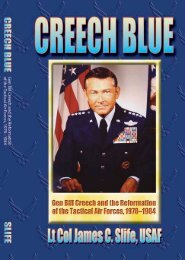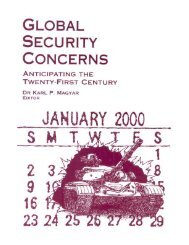Inside the Cold War - Project Gutenberg Consortia Center
Inside the Cold War - Project Gutenberg Consortia Center
Inside the Cold War - Project Gutenberg Consortia Center
Create successful ePaper yourself
Turn your PDF publications into a flip-book with our unique Google optimized e-Paper software.
THE LEADERS<br />
appointed head of <strong>the</strong> AEC’s atomic reactor program, Rickover<br />
wasted no time in prevailing upon him to consider organizing<br />
a Naval Reactor Program within <strong>the</strong> AEC. Adm Earle Mills,<br />
who had been impressed with Rickover while working in<br />
BuShips and who supported <strong>the</strong> nuclear propulsion concept,<br />
agreed that a naval branch should be created within AEC’s<br />
Division of Reactor Development. Hafstad was convinced, and<br />
Rickover was named director of <strong>the</strong> new branch.<br />
Rickover’s assignment went largely unnoticed until seniors<br />
within <strong>the</strong> Navy and <strong>the</strong> Washington community realized that<br />
Captain Rickover had taken command of both Navy’s and<br />
AEC’s nuclear propulsion activities. He could now send<br />
priority requests to himself from ei<strong>the</strong>r office, obtain instant<br />
“sign-off,” and proceed on his merry way. Rickover in no way<br />
abused his positions, but he did drastically cut red tape to<br />
move <strong>the</strong> program along. He was a genius at selling ideas to<br />
AEC and industry while saving money for <strong>the</strong> Navy. He<br />
convinced Westinghouse that building smaller nuclear power<br />
plants for ship propulsion would be an ideal way to pursue<br />
<strong>the</strong> goal of building industrial nuclear power plants.<br />
Westinghouse also got on board Rickover’s drive to divert<br />
fissionable materials from bombs to power reactors. The AEC<br />
and a number of influential members of Congress were<br />
delighted with a US industry sharing <strong>the</strong> new technology and<br />
creating revolutionary business potential.<br />
Meanwhile, Captain Rickover continued to build his small<br />
empire. He took over Tempo-3, a group of prefabricated<br />
buildings set up on Constitution Avenue during <strong>the</strong> <strong>War</strong> to<br />
prevent overcrowding. He <strong>the</strong>n ripped out all carpeting and<br />
o<strong>the</strong>r items that reflected a “cushy” Washington environment<br />
and established work schedules of 14 to 16 hours a day.<br />
Money was still scarce, but Rickover somehow managed to<br />
leach enough from <strong>the</strong> Navy and o<strong>the</strong>r sources to continue<br />
developing a nuclear reactor and a suitable submarine. He<br />
selected <strong>the</strong> Nautilus to receive <strong>the</strong> new propulsion engine.<br />
In <strong>the</strong> late 1940s and early 1950s, Rickover began to create<br />
serious problems for himself and his programs. He had<br />
become, or perhaps had always been, a complete nonconformist.<br />
He fought convention and bureaucracy at every turn. He<br />
developed complete contempt for th e conventional Navy and<br />
25






